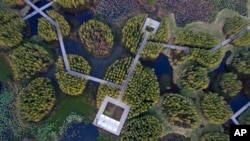A Chinese architect has been making the case for China and other countries to create so-called “sponge cities” - cities with large amounts of plants and trees laid out in a way to prevent flooding.
The goal is to reduce the bad effects of extreme weather due to climate change.
In a talk with the Associate Press, Yu Kongjian described his vision for cities that are not harmed by temperature changes, heavy rainfall, or too little rainfall.
Yu criticizes much of Asia’s modern cities, buildings, and roads for being built on ideas brought from Europe. He says such designs are not a good fit for the heavy rains that take place over much of the Asian continent. He points to recent floods that have caused damage in many Asian cities as evidence of the mismatch.
“There’s no resilience at all,” Yu said of the hard materials like stone and steel used to build major cities. These cities use pipes and channels to control the movement of water. “Those are useless, they will fail and continue to fail,” he said.
Instead, Yu supports using natural resources to create cities that can deal with water.
Worldwide change
Yu’s ideas are part of a change among landscape design and civil engineering professionals worldwide. These professionals are increasingly working more with the natural environment. By creating large spaces to hold water in city centers — such as parks and ponds — stormwater can be held, helping prevent floods, Yu said.
These structures could also offer ways for water to go slowly through the soil and fill up underground water supplies for times of too little rain.
“The idea of a sponge city is to recover, give water more space,” Yu said.
China
A turning point in China’s awareness of climate change and urban change came about ten years ago, Yu said. A powerful flood hit the capital city of Beijing in July 2012.
Beijing’s biggest rain in 61 years was too much for the drainage systems. Water filled the city center and flooded the edges of the city. At least 77 people died.
Yu at the time sent a letter to Beijing’s party secretary, Guo Jinlong. Yu called for a change in how the government deals with city roads and buildings. He continued to send letters to top officials, including China’s leader Xi Jinping.
At a government meeting the next year, China included the idea of sponge cities as part of a national plan.
In 2014, the central government issued a ruling: Reuse 70 percent of rainwater runoff in 20 percent of urban areas by 2020, and in 80 percent of such areas by 2030.
The following year the government launched 16 sponge city projects for testing, adding 14 more in 2016.
The ruling and government financial support led to an increase in water-absorbing infrastructure, including in large cities such as Beijing, Shanghai and Shenzhen.
Unclear future
At times, the sponge city idea has been difficult to put into effect in China. Misuse of finances, lack of expertise in sponge city planning, and other issues have caused some projects to fail.
In April, the Ministry of Housing and Urban-Rural Development said some cities had “inaccurate understanding” of sponge city-building methods. The agency warned against using money meant for sponge city construction for other general projects, such as buildings and roads.
Those rules were issued after rains and floods in the city of Zhengzhou killed 398 people last summer.
Notably, Zhengzhou was one of the test sponge cities, with a planned investment of $7.4 billion. Some questioned whether sponge city projects work at all.
But an investigation by the State Council, released in January, found that money meant for sponge city projects had been misspent. Only one-third of the money went to what the government defined as sponge city ideas.
The investigation found that officials were still “building flower beds” at a time when the whole country helped to support Zhengzhou’s rescue.
I’m John Russell.
Emily Wang Fujiyama reported this story for The Associated Press. John Russell adapted the story for Learning English.
_________________________________________________________________
Words in This Story
architect – n. a person who designs buildings or landscapes
vision -- n. a clear idea about what should happen or be done in the future
mismatch -- n. a situation in which two people or things that are not suited to each other are together
resilience – n. the ability to become strong, healthy, or successful again after something bad happens
infrastructure – n. the basic equipment and structures (such as roads and bridges) that are needed for a country, region, or organization to function properly
drainage – n. the act or process of draining something : the act or process of removing water or liquid from a place or thing
runoff – n. water from rain or snow that flows over the surface of the ground into streams












Forum